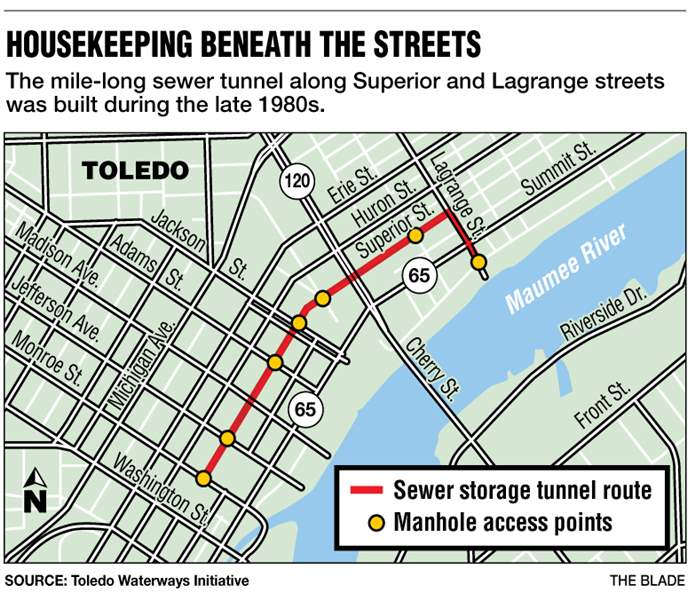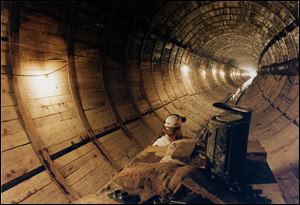
20 years of gunk to be cleaned from sewer holding tank
Officials promise minimum smell
3/11/2012
The Blade
Buy This Image

The mile-long, 5.7 million-gallon sewer tank 67 feet beneath under Superior and Lagrange streets was built during the late 1980s.
Deep beneath downtown Toledo, starting near left field at Fifth Third Field and running directly under center ice at the Huntington Center and past the Valentine Theatre on its way to a riverfront pumping station in the North End, is a giant cesspool that retains runoff during downpours to lighten the load on Toledo's sewage treatment plant.
And after more than 20 years of operation, downtown Toledo's 5.7 million-gallon sewage tank is due for its first clean-out.
The three-month, $941,804 project won't cause the same sorts of disruptions along Superior Street that occurred when it was built during the late 1980s: no huge access shafts needed to lower men and machines as deep as 67 feet below the surface to dig the 18-foot hole into which the concrete sewer tunnel, with a 13 1/2-foot inside diameter, was built.
All that will be involved, project planners say, is running hoses down into the tunnel through which several decades' worth of sewer gunk will be slurped into vacuum trucks, ground up, and hauled away to appropriate landfills.

Although it won't require any big holes in the streets or associated detours, the work is likely to be rather noisy, and maybe even a bit stinky. The vacuum trucks will be stationed near seven manholes along the route, which is likely to require short-term lane closings during the three months or so that the underground purge is expected to require.
"It's a little unnerving," said Matt Lentz, director of marketing and public relations at the Valentine Theatre, who was one of several downtown business representatives briefed recently about the work. But project planners have "done their best to reassure us" that efforts will be made to avoid conflicts with events at the Valentine, he said.
"I realize it has to be done too," Mr. Lentz said. "I hope, I believe they'll work with us."
The mile-long tunnel that runs under Superior and Lagrange streets was one of three the city dug at about the same time to provide storage capacity during storms so overflows of raw sewage from Toledo's treatment plant would occur less often. The other two, which run under neighborhood streets on opposite sides of Swan Creek in central and South Toledo, are scheduled for similar cleanings next year.
"During storms, they fill. At the end of the storms, when flow subsides, we pump out what's there," said Bob Harbron, the program director for Black & Veatch, a city consultant.
Over time, grit, "road sediment," and just about anything else that could fit through storm-drain grates has accumulated on parts of the tunnel's floor.
"Most of the sediment is down at the lower end of the tunnel," said Mr. Harbron, who walked the length of it in 2007. The material is up to four feet deep in places, but "some areas of the tunnel are pretty clean," he said.
The work is all part of the Toledo Waterways Initiative, a $521 million campaign to further reduce raw-sewage overflows into the Maumee River, Swan Creek, and the Ottawa River.
Cleaning the tunnels will restore them to full capacity, thus helping the city meet that campaign's goals. Other major parts of the campaign include building new sewer lines in some neighborhoods to separate sewage from storm runoff and adding underground storage in other areas of the city to spread storm flow out to keep the treatment plant from being overloaded.
George Robinson II, a deputy director of the Toledo Department of Public Utilities overseeing the Toledo Waterways Initiative, said the work schedule for cleaning the Superior tunnel won't be set up until after the contract with Doetsch Environmental Service Inc. of Warren, Mich., the apparent winning bidder, is finalized. The city's goal, he said, is to have it finished by October.
The contractor will have to comply with city noise ordinances and is "not allowed to have debris exposed to the environment" to keep odor release to a minimum, Mr. Robinson said.
Mr. Harbron said sealed containers into which the tunnel gunk will be pumped will be removed from the work sites each night.
Officials believe that years of being washed by water flowing through the tunnel should have knocked down the material's stink potential -- but the true consequences of stirring it all up remain unknown.
"If it gets to be a problem, there are terms in the contract that supplemental measures can be added" to control odors, Mr. Harbron said.
"We hope that the contractor uses their best judgement," Mr. Robinson said. "Some of the material has been down there for [close to] 25 years."
The city intends for the contractor to work around game and event schedules at Fifth Third Field, Huntington Center, and the Valentine to minimize disruptions, Mr. Robinson said.
Once the project's schedule is determined, Mr. Harbron said, officials will schedule additional meetings to explain the work to business operators on Superior, St. Clair, and Huron streets and to residents of homes near the tunnel's route north of Cherry Street.
Greg Setola, manager of game-day operations for the Mud Hens, said the front office has been assured that the work won't interfere with baseball games.
"The work day will conclude early on dates that we have home games, in order to make sure that the fan experience is not impeded in any way," he said.
Contact David Patch at: dpatch@theblade.com or 419-724-6094.